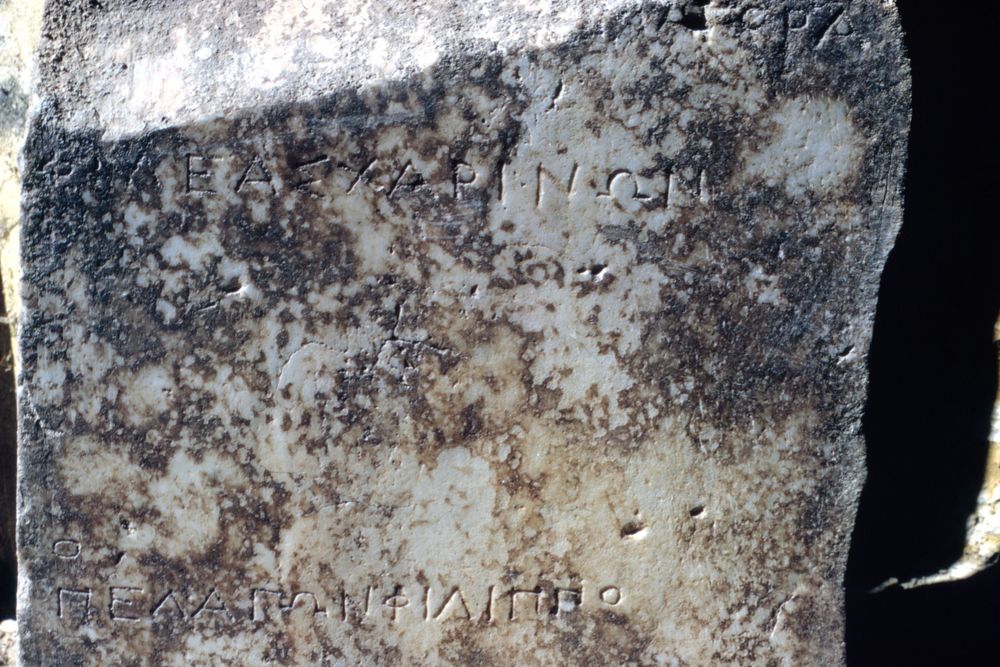EpiDoc XML:
IGCyr1164002
Trismegistos ID:
738713
Source description
Support: Lower part of a marble stele with all edges chipped (w: 0.405 × h: 0.62 × d: 0.215).
Layout: Inscribed on the very worn and stained face with irregular alignment.
Letters: 0.018; letters rather regular in shape, some of them keeping traces of preliminary dots; some characters are obscure (an unfinished phi at line 3?); dissymmetrical nu, pi once with equal hastae, twice with unequal ones, slanting sigma, horseshoe omega.
Date: Perhaps third century BC (lettering).
Findspot: Found in 1974 by the American team of D. White at Cyrene ➚: Enclosed sanctuary of Demeter and Kore, area 2, 1.2.
Last recorded location: Cyrene Museum, Storeroom of the American excavations, 69.208; 74-91. Seen by J. Reynolds at Shahat: in the Storeroom of the American excavations. Not seen by IGCyr team.
Text constituted from: Transcription from editor and photographs.
Bibliography
Reynolds 2012, n. A.8 (no image) , and Dobias-Lalou, BE, 2013.480, whence SEG, 62.1791; IGCyr 116400 ➚.
Text
Apparatus
1a: (vac. 2 lines) Reynolds 2012: [ - - - - - - - - - - ] | [------] Reynolds 2012
2: Φιλέας Χαρίνω {ν}: Φιλείας Χαρίνω Ν[c. 3 - 4] IGCyr; φιλείας χάριν ΩΝ Reynolds 2012
2a: (vac. 4 lines) Reynolds 2012: [ - - - - - - - - - - ] | [ - - - - - - - - - - ] | [ - - - - - - - - - - ] | [------] Reynolds 2012
3: +: Φ(vac.) IGCyr; [---] Reynolds 2012
4: Φιλίππ⸢ω⸣: Reynolds 2012, IGCyr
French translation
[Untel] fils d'Athènagoras. Phileas fils de Kharinos N[---]. PH. Pélagôn fils de Philippos.
English translation
[So-and-so] son of Athenagoras. Phileas son of Charinos N[---]. PH. Pelagon son of Philippos.
Italian translation
[Il tale] figlio di Athenagoras. Phileas figlio di Charinos N[---]. PH. Pelagon figlio di Philippos.
Commentary
Some changes have been brought to this edition, thanks to the photograph now available.
At line 2, we prefer to read personal names rather that Reynolds' alternative suggestion of the formula meaning 'for the sake of friendship', which is attested much later. The last preserved letter nu might be the beginning of νέος, rather than the numeral 50 giving the age (as suggested by Dobias-Lalou, BE2013.480), because this feature is also later.
At line 3, Reynolds could see no letter after the supposed phi, which is only a flat circle. The photograph now confirms this view.
Although found in the sanctuary of Demeter and Kore, this stone has certainly been brought there from elsewhere. Rather than a list of officials of some kind related to the sanctuary, it might be a funerary stele brought from the nearby West Necropolis. Alternatively, given the queer cutting technique, the names were perhaps graffiti appended on a monument. The gymnasium, in the agora quarter, might be the original place as well.
CC BY-NC-SA 4.0 Deed Attribution-NonCommercial-ShareAlike 4.0 International License.
All citation, reuse or distribution of this work must contain a link back to DOI: https://doi.org/10.60760/unibo/igcyrgvcyr2 and the filename (IGCyr000000 or GVCyr000), as well as the year of consultation.

